Post by reTrEaD on Dec 6, 2018 22:55:01 GMT -5
BS = Binary Switching?
BS = Bus Structure?
BS = (something more traditional and obvious)?
You decide.
In this thread I'll present three different type of Binary Switching strategies. They apply to (but are not limited to) a floating Bus Structure which is useful for (but not limited to) those "every possible combination" schemes we occasionally see.
Pack a lunch and fill your canteen before we get started. This could be a long, meandering journey.
Every Possible Combination.
If we're talking about a single coil, there is only one unique combination that's worth talking about. The one that produces sound. Flipping the phase on a single coil when no other coils are present is rather meaningless.
When it comes to two coils, there are exactly six combinations (excluding those which have a cap or resistor involved) possible. We can achieve all six of those with a relatively simple rotary switch that has at least 3 poles and six positions.
When it comes to three coils, we'll need at least 5 poles and 30-ish positions. That's just not gonna happen. So where do we go from here?
One possible solution would be to employ a single pole rotary switch on each lead of each pickup and a floating Bus Structure.
Floating Bus Structure
This isn't a new concept. We've seen this before in the Game Changer, although in that case it was an automated system. Here we'll be manually switching each connection. This is a cumbersome process. It isn't something to design around for a guitar one would use on stage. But it will make it possible to audition every possible combination. This could be useful in determining what a particular person might want to include in a reduced set of combinations on a stage-worthy guitar.
We'll need two fixed buses (one hot and one ground) plus a number of floating buses. How many floating buses? One for every possible series link. So an 8-bus structure could provide enough capability for a seven coil arrangement. That's a bit of overkill but I chose to compare methods of serving an 8-bus structure because 23 = 8.
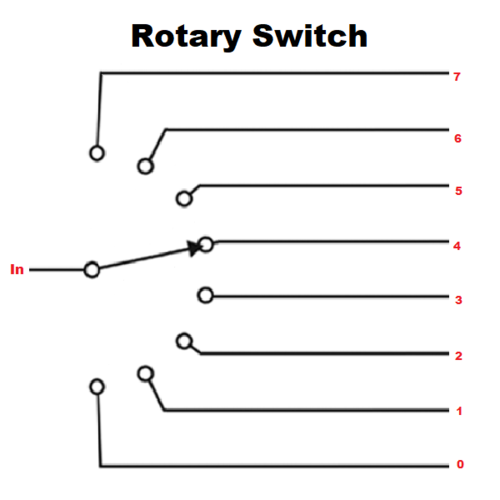

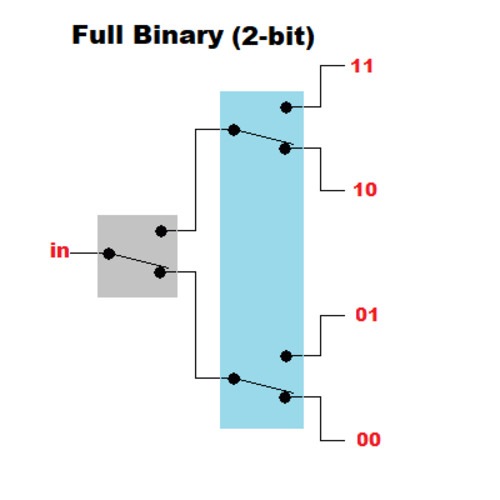
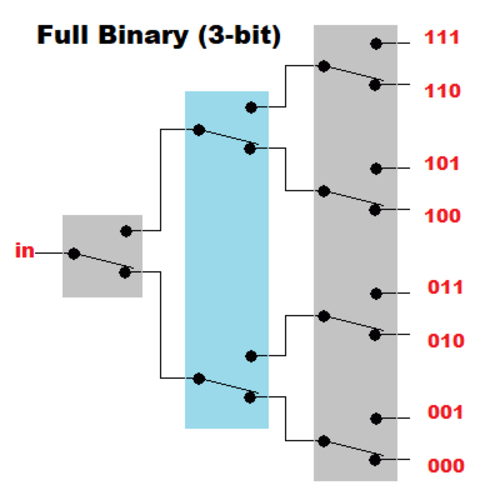
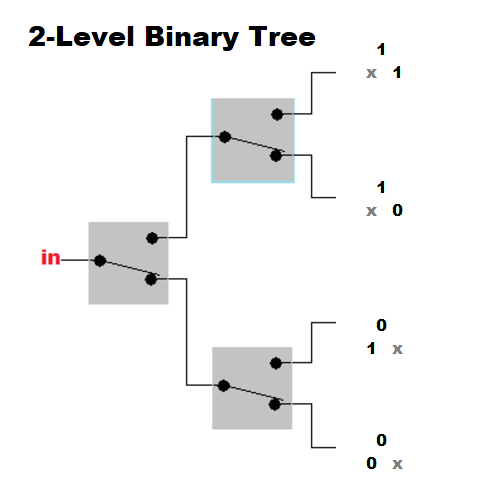
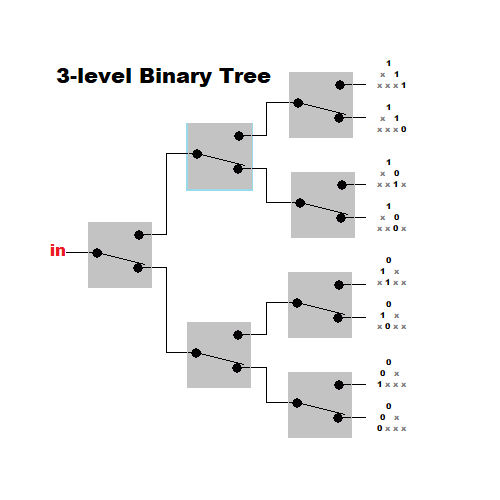
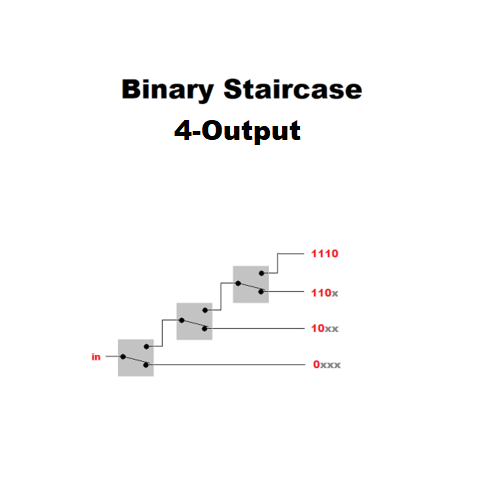
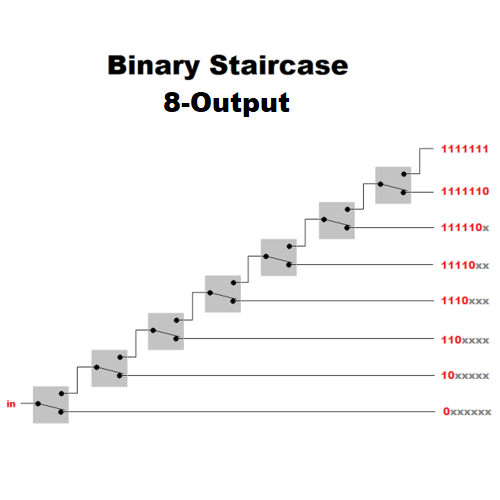
BS = Binary Staircase?
If you want to grow one of those every possible combination schemes, this seems fertile unless you have a lot of ground to till.
We could also use 4PDT switches in a binary staircase arrangement rather than a 4PxT rotary switch for other applications. But that probably falls under the heading: Just because you can, doesn't mean you should.
Which is best? Rotary, Full Binary, or Binary Staircase? That really depends on what's most important to you. But now you have some information to make a more informed decision.
Options are.
BS = Bus Structure?
BS = (something more traditional and obvious)?
You decide.

In this thread I'll present three different type of Binary Switching strategies. They apply to (but are not limited to) a floating Bus Structure which is useful for (but not limited to) those "every possible combination" schemes we occasionally see.
Pack a lunch and fill your canteen before we get started. This could be a long, meandering journey.
Every Possible Combination.
If we're talking about a single coil, there is only one unique combination that's worth talking about. The one that produces sound. Flipping the phase on a single coil when no other coils are present is rather meaningless.
When it comes to two coils, there are exactly six combinations (excluding those which have a cap or resistor involved) possible. We can achieve all six of those with a relatively simple rotary switch that has at least 3 poles and six positions.
When it comes to three coils, we'll need at least 5 poles and 30-ish positions. That's just not gonna happen. So where do we go from here?
One possible solution would be to employ a single pole rotary switch on each lead of each pickup and a floating Bus Structure.
Floating Bus Structure
This isn't a new concept. We've seen this before in the Game Changer, although in that case it was an automated system. Here we'll be manually switching each connection. This is a cumbersome process. It isn't something to design around for a guitar one would use on stage. But it will make it possible to audition every possible combination. This could be useful in determining what a particular person might want to include in a reduced set of combinations on a stage-worthy guitar.
We'll need two fixed buses (one hot and one ground) plus a number of floating buses. How many floating buses? One for every possible series link. So an 8-bus structure could provide enough capability for a seven coil arrangement. That's a bit of overkill but I chose to compare methods of serving an 8-bus structure because 23 = 8.

Rotary Switch
We'll need thirteen 8-position rotary switches for a seven coil guitar. (one lead of one of the pickups can be wired directly to ground).
For a HHH, we'd need eleven 7-position switches.
For a HSH, we'd need nine 6-position switches.
For a HH or HSS, we'd need seven 5-position switches.
For a SSS or HS, we'd need five 4-position switches.
Add more to the total number of switches if we want to use a capacitor or pot to bypass or couple any of the coils. But the number of buses can remain the same.
Pro:
It's relatively intuitive and if we use chicken head knobs and a numbered indications on the mounting plate, we can easily see which bus we're connecting to.
Cons:
It could get fairly pricey.
It takes a fair amount of real estate.
Let's look at other options for switching.
We'll need thirteen 8-position rotary switches for a seven coil guitar. (one lead of one of the pickups can be wired directly to ground).
For a HHH, we'd need eleven 7-position switches.
For a HSH, we'd need nine 6-position switches.
For a HH or HSS, we'd need seven 5-position switches.
For a SSS or HS, we'd need five 4-position switches.
Add more to the total number of switches if we want to use a capacitor or pot to bypass or couple any of the coils. But the number of buses can remain the same.
Pro:
It's relatively intuitive and if we use chicken head knobs and a numbered indications on the mounting plate, we can easily see which bus we're connecting to.
Cons:
It could get fairly pricey.
It takes a fair amount of real estate.
Let's look at other options for switching.

Binary Switching (single switch)
Minitoggles are small and inexpensive. A SPDT takes up a tiny bit of real estate. But what can we do with just one? Not much.
When the lower throw is connected (0) we connect to one bus, when the upper throw is connected (1) we connect to the other bus. But two a two bus structure isn't useful.
Nothing more to see here. Let's move on.
We're gonna need more switches!
Minitoggles are small and inexpensive. A SPDT takes up a tiny bit of real estate. But what can we do with just one? Not much.
When the lower throw is connected (0) we connect to one bus, when the upper throw is connected (1) we connect to the other bus. But two a two bus structure isn't useful.
Nothing more to see here. Let's move on.
We're gonna need more switches!

Full Binary (2-bit)
Adding a second switch, in this case a DPDT, adds some functionality. We can have two floating buses. That's enough for a 3 coil arrangement. SSS or HS. Not bad at all!
Pros: Cost is low. Real estate is minimal.
Cons: It's less intuitive than a rotary since we need to start thinking in binary. But since we're only dealing with two switches and four possible combinations it's still quite manageable. Also, the second switch (DPDT) will cost about the same as two SPDTs.
We seem to be on a good path here. Let's expand.
Adding a second switch, in this case a DPDT, adds some functionality. We can have two floating buses. That's enough for a 3 coil arrangement. SSS or HS. Not bad at all!
Pros: Cost is low. Real estate is minimal.
Cons: It's less intuitive than a rotary since we need to start thinking in binary. But since we're only dealing with two switches and four possible combinations it's still quite manageable. Also, the second switch (DPDT) will cost about the same as two SPDTs.
We seem to be on a good path here. Let's expand.

Full Binary (3-Bit)
Now we're talkin'! By adding just one more switch we can get as many buses as we'll need for an absurd 7-coil guitar.
Pros: Just three switches. The 4PDT does take up more real estate but the three switches together still have a much smaller footprint than a rotary. This still it still has a slight price advantage over a rotary and a chicken head knob.
Cons: 4PDTs tend to be a bit pricey. Even if we compare to the price of two DPDT or four SPDTs, they cost more. We've moved farther down the 'think in binary' path and that's not great.
Unfortunately we can't expand any farther using the same strategy. That would require a 8PDT switch. Not gonna happen. Besides, do we really need to support more than 7 coils?
Now we're talkin'! By adding just one more switch we can get as many buses as we'll need for an absurd 7-coil guitar.
Pros: Just three switches. The 4PDT does take up more real estate but the three switches together still have a much smaller footprint than a rotary. This still it still has a slight price advantage over a rotary and a chicken head knob.
Cons: 4PDTs tend to be a bit pricey. Even if we compare to the price of two DPDT or four SPDTs, they cost more. We've moved farther down the 'think in binary' path and that's not great.
Unfortunately we can't expand any farther using the same strategy. That would require a 8PDT switch. Not gonna happen. Besides, do we really need to support more than 7 coils?
Just for fun, lets examine some different avenues as starting points.

Binary Tree (2-level)
Hmmm. This looks interesting. By using separate switches for the second level, we can avoid the need for a more complicated switch. Two SPDTs instead of one DPDT. That's nice. Three switches aren't too difficult to manage. And it's rather visual, if we arrange the switches in a triangular pattern. Less so if we flatten them into a straight line. Not sure where this might lead when we go to the next level though.
Somewhat troubling is the 'don't care' situations represented by the grey x s.
Hmmm. This looks interesting. By using separate switches for the second level, we can avoid the need for a more complicated switch. Two SPDTs instead of one DPDT. That's nice. Three switches aren't too difficult to manage. And it's rather visual, if we arrange the switches in a triangular pattern. Less so if we flatten them into a straight line. Not sure where this might lead when we go to the next level though.
Somewhat troubling is the 'don't care' situations represented by the grey x s.

Binary Tree (3-level)
Oh my, this got very ugly very quickly.
I'm far less concerned about the addition of four more switches than I am about the difficulty of keeping track of which bus we're connected to. If we keep things in a triangular pattern (and waste a significant amount of real estate, it's still tough. And all those don't care situations are really piling up.
If we flatten this physically so all the switches are in a straight line it becomes much worse.
Oh my, this got very ugly very quickly.
I'm far less concerned about the addition of four more switches than I am about the difficulty of keeping track of which bus we're connected to. If we keep things in a triangular pattern (and waste a significant amount of real estate, it's still tough. And all those don't care situations are really piling up.
If we flatten this physically so all the switches are in a straight line it becomes much worse.
I'm not fond of this. Let's explore a completely different approach.
It's time to think outside thebox triangle!
It's time to think outside the

Binary Staircase (4-output)
I revisited that little corner of my mind I like to refer to as the pole vault and quickly realized I have a lot of thoughts on how best to use the pole of a multiple-throw switch but hadn't invested nearly so much thought into various ways of cascading SPDTs.
So it was time for a daydream, to allow thoughts to perform a pole dance. I think something useful might have shaken out.
Rearranging the three SPDTs we had in our 2-level binary tree, we can retain four outputs just like the tree. But now some nice things seem to happen. I like the patterns that are emerging.
This shows some promise. Let's just leap forward to the next major step.
I revisited that little corner of my mind I like to refer to as the pole vault and quickly realized I have a lot of thoughts on how best to use the pole of a multiple-throw switch but hadn't invested nearly so much thought into various ways of cascading SPDTs.
So it was time for a daydream, to allow thoughts to perform a pole dance. I think something useful might have shaken out.
Rearranging the three SPDTs we had in our 2-level binary tree, we can retain four outputs just like the tree. But now some nice things seem to happen. I like the patterns that are emerging.
This shows some promise. Let's just leap forward to the next major step.

Binary Staircase (8-Output)
As hoped, this looks just fine when expanded.
Pros:
The switches are cheap.
A relatively modest amount a real estate is necessary.
The switches can be arranged in a line.
The settings are visual and intuitive.
It's flexible.
Con:
The sheer number of switches required means this won't look pretty unless you're a fan of switch rash. For a HSH, we'll need nine 5-switch arrays. 9 x 5 = 45 switches. Yikes!
5 x 3 = 15 switches for a SSS ... this is reasonable.
As hoped, this looks just fine when expanded.
- The first thing we notice is that all the don't cares exist to the right.
- Everything that does matter exists to the left.
- The deciding point? The left-most switch which gives us a zero. (that will be dead-easy to spot)
- Putting the switches in a straight line will be a good thing.
- We can have any number of buses we desire just by adding or subtracting a step.
Pros:
The switches are cheap.
A relatively modest amount a real estate is necessary.
The switches can be arranged in a line.
The settings are visual and intuitive.
It's flexible.
Con:
The sheer number of switches required means this won't look pretty unless you're a fan of switch rash. For a HSH, we'll need nine 5-switch arrays. 9 x 5 = 45 switches. Yikes!
5 x 3 = 15 switches for a SSS ... this is reasonable.
BS = Binary Staircase?
If you want to grow one of those every possible combination schemes, this seems fertile unless you have a lot of ground to till.
We could also use 4PDT switches in a binary staircase arrangement rather than a 4PxT rotary switch for other applications. But that probably falls under the heading: Just because you can, doesn't mean you should.
Which is best? Rotary, Full Binary, or Binary Staircase? That really depends on what's most important to you. But now you have some information to make a more informed decision.
Options are.








